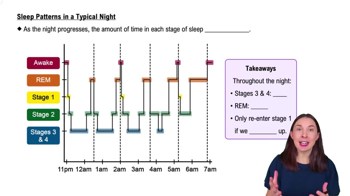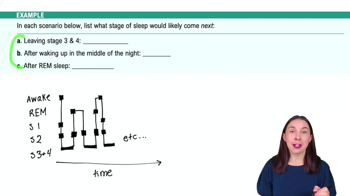Table of contents
- 1. Introduction to Psychology1h 43m
- 2. Psychology Research2h 20m
- 3. Biological Psychology2h 41m
- 4. Sensation and Perception28m
- 5. Consciousness and Sleep32m
- 6. Learning41m
- 7. Memory34m
- 8. Cognition37m
- 9. Emotion and Motivation35m
- 10. Developmental Psychology33m
- 11. Personality48m
- 12. Social Psychology41m
- 13. Stress and Health41m
- 14. Psychological Disorders44m
- 15. Treatment47m
5. Consciousness and Sleep
Sleep
Struggling with Psychology?
Join thousands of students who trust us to help them ace their exams!Watch the first videoMultiple Choice
Stanley Schachter and Jerome Singer's _____ proposed that physical arousal and a labeling of the arousal based on cues from the surrounding environment result in the experience of an emotion.
A
facial feedback hypothesis
B
cognitive arousal theory
C
common sense theory
D
cognitive mediational theory
 Verified step by step guidance
Verified step by step guidance1
Identify the key components of the problem: the question is about a theory proposed by Stanley Schachter and Jerome Singer that involves physical arousal and labeling based on environmental cues.
Understand the context: Schachter and Singer's theory is related to how emotions are experienced, focusing on the interaction between physiological arousal and cognitive processes.
Review the options provided: facial feedback hypothesis, cognitive arousal theory, common sense theory, and cognitive mediational theory.
Analyze each option: The facial feedback hypothesis suggests that facial expressions can influence emotions, which does not match the description. The common sense theory implies emotions lead to physical reactions, which is not the focus here. The cognitive mediational theory involves cognitive appraisal before emotion, which is different from labeling arousal.
Conclude with the correct theory: The cognitive arousal theory, also known as the two-factor theory of emotion, aligns with the description as it involves both physiological arousal and cognitive labeling to experience emotion.

 3:25m
3:25mWatch next
Master Circadian Rhythms with a bite sized video explanation from Hannah Gordils
Start learningRelated Videos
Related Practice


































































































![Race, Genes and IQ Differences | Bret Weinstein [Mini Clip]](https://img.youtube.com/vi/IztL_m3pd70/mqdefault.jpg)



































































































